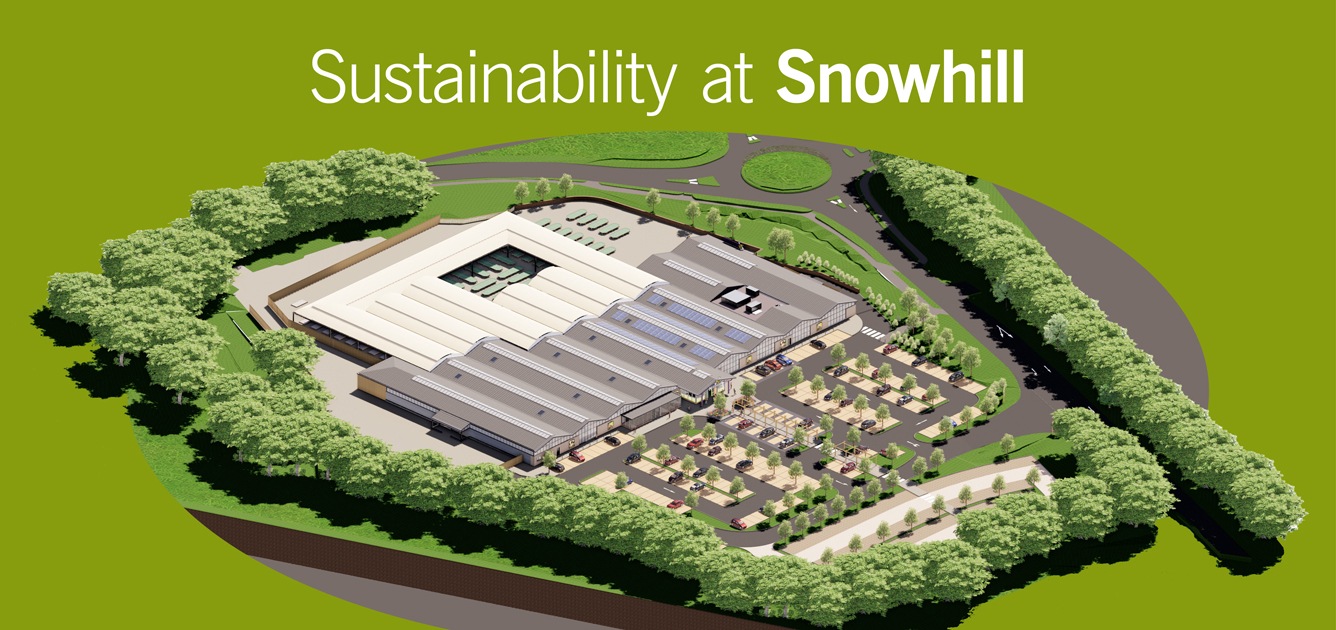
Rainwater Harvesting
Rainwater is collected from the building and fed into a 50,000 litre underground retention tank where the stored water is used to water plants across the site.
Sustainable Urban Drainage
Rainwater falling on the car park surface drains into the permeable car parking bays into a stone layer (providing water treatment) which then connects into the same system as the main roof water draining to the rainwater harvesting tank. Flow into the adjacent stream is restricted to greenfield rates which protects downstream flooding. Excess storm water volume is stored in tanks and the stone sub-base under the car park.
Thermally Efficient Building
Haskins Garden Centre Snowhill produces 40% less Carbon Dioxide than the Building Regulations Target Emission Rate (TER), this is thanks to high efficiency building services systems; including LED lighting, heat recovery ventilation systems, natural ventilation measures, photovoltaic panels and high thermal and solar efficiency of the building fabric.
Solar / Energy Efficiency
930m² of Photovoltaic panels are located on the roof of the Garden Centre, which provides 20% of the Garden Centres annual Electricity requirements and a saving 77 tonnes of Carbon Dioxide every year. High efficiency, low energy LED lighting has been installed throughout the building and external spaces, incorporating daylight dimming and automatic detection, to further reduce energy consumption. Energy efficient ventilation systems have been installed throughout the Garden Centre, reclaiming heat from the space and using it to warm the incoming fresh air. The Garden Centre retail area is a naturally ventilated space, incorporating automatic controls to maintain a comfortable environment. Furthermore, to future proof the store in the ever increasing requirement for Plug-in Electric Vehicles, provision has been made for electric car charging in the future.
Trees / Landscaping
Apart from their great amenity value, trees and shrubs have a vital environmental role. Some of the main benefits are described below.
- Trees provide valuable shade in summer, helping to keep the soil surfaces cool and diminishing evaporation; all plant leaves, notably those trees and shrubs with larger leaves, help to absorb dust and pollutants from the atmosphere.
- All plants absorb carbon dioxide and produce oxygen from their leaves, contributing towards the fight against the global rise in the level of carbon dioxide in the atmosphere.
- By intercepting rainfall and absorbing moisture from the ground, all plants help to reduce run off, thus helping to mitigate potential flooding in river systems.
- Native tree and shrub species, which have evolved in relation to the climate and soils of the UK, have developed special relationships with other species, particularly invertebrate species, for which they act as hosts. For example, oak trees support up to 284 different species of insect, birch 229 species, Scots pine 91 species and beech 64 species. This diversity of insects is essential for supporting natural food chains, particularly for birds.
At Snowhill existing mature trees have been retained along each of the four site boundaries. These include oak, beech, hornbeam, sweet chestnut, larch and Scots pine. Mature trees are essential in maintaining continuity of biodiversity within a development site while new plantings establish and mature. New tree planting has been a key design objective at Snowhill and 114 new trees have been planted within the garden centre grounds. These include native and carefully selected non-native species which still have wildlife value. In addition to tree planting, large areas of native shrubs have been planted, amounting to some 1400 plants in total, along the northern and eastern boundaries of the garden centre. These will form linear copses adjoining the gardens of neighbouring houses. Further areas of native shrubs and new hedges have been planted along the southern boundary and the western boundary with West Park Road. Ornamental plantings within the garden centre are also important for encouraging biodiversity as many provide nectar for pollinating insects and fruits which are a food source for birds and small mammals.
Taken as a whole, all the existing and new plantings within the Snowhill Garden Centre will make an important and increasing contribution to biodiversity and overall biomass within the local area.
